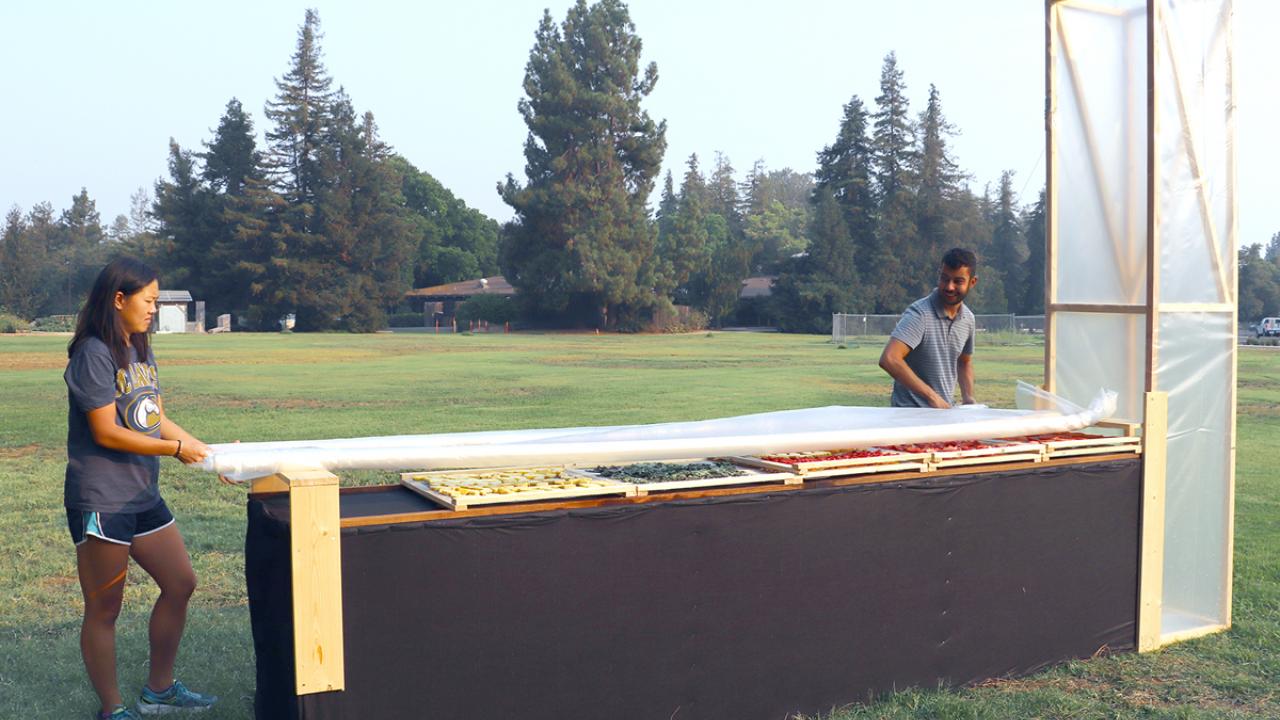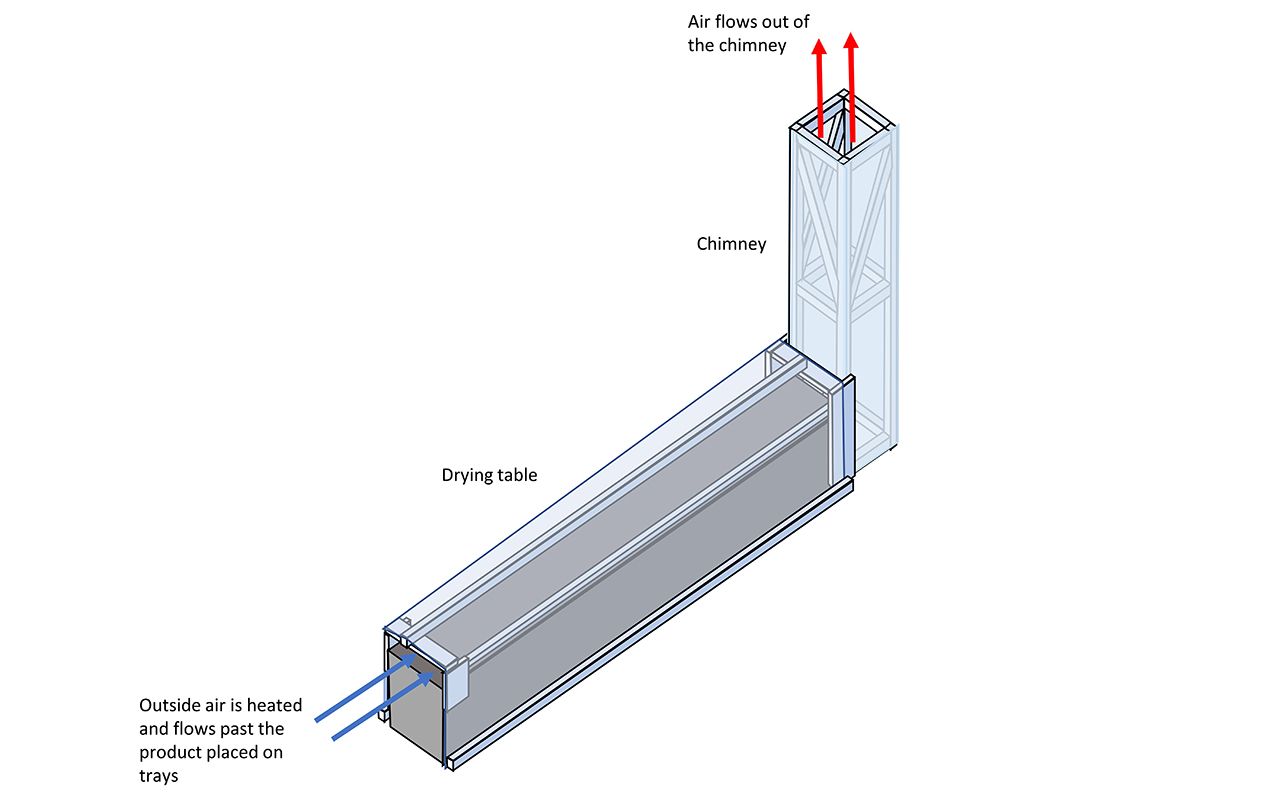
The Chimney Solar Dryer Manual provides an introduction to this efficient, low-cost solar dryer designed by UC Davis researchers. The manual includes directions for how to build the chimney solar dryer and how to use it to dry fruits and vegetables.
What's inside the manual:
The Chimney Solar Dryer Manual includes an introduction (shared below) and two main sections:
Introduction to the 'Chimney Solar Dryer Manual'
The UC Davis chimney solar dryer was designed to provide efficient drying even in hazy or partially cloudy conditions. Constructing the dryer is simple, and it can be built from low-cost materials found locally in markets and shops around the world. The objective of this manual is to provide the knowledge needed to build and use the chimney solar dryer, along with the basic value and process of using the sun to dry fruits, vegetables and other foods. This manual will be useful for growers, farmer cooperatives, trainers, development implementers, researchers, and others.
There are two key and unique characteristics of the chimney solar dryer:
- The chimney ensures continuous airflow around the product, thus increasing the speed of drying compared to other designs.
- The dryer’s large heat-collection area ensures high temperatures and rapid moisture removal.
Background on drying fruits and vegetables
Fruits and vegetables are highly profitable commodities for both small-scale and large-scale farmers. Unfortunately, fresh produce is very perishable and postharvest losses can be quite high, especially in developing countries. The FAO (2011) estimates that roughly one-third of edible products are lost between the growing site and the consumer. In the developing world, the majority of these losses occur soon after harvest.
Many fruits and vegetables have production peaks when, for reasons such as season, weather, or planting time, high volumes of produce are harvested in a short period. During these peaks, product quality is often high, but prices are typically low because there is too much product available. Shortly after the harvest, after the glut of produce has been sold, prices rise.
Farmers can take advantage of the higher prices by storing some of their harvest. The primary tool for storing fresh fruits and vegetables is refrigerated cold rooms, which can extend shelf life by several weeks for some crops and up to a year for others. Where cold storage is not available or economically justified, good quality excess product frequently goes to waste. Freezing and canning are common strategies for processing peak production and adding value, but may require expensive facilities, often not available to small-scale farmers.
An alternative for many crops is drying. In certain cultures, dried fruits and vegetables are a staple part of the diet, providing important nutrients in the lean season. In addition to extending the marketing season, drying reduces the volume and weight of products resulting in lower transportation and storage costs.

What is a chimney solar dryer?
The chimney solar dryer is a solar dryer designed by UC Davis researchers with the Horticulture Innovation Lab. It is a low-cost structure that can be made from locally available materials, and that reduces drying time compared to traditional solar dryers.
How does this solar dryer work?
The dryer consists of a long table covered with black plastic or fabric that is connected to a chimney at one end. The product is placed on mesh trays along the length of the table. A clear plastic sheet placed over the trays and table creates a tunnel that traps solar energy, heating the air and reducing its relative humidity. The dry, heated air accelerates moisture loss from the heated product, and the warm, moist air leaves the dryer through the chimney. The dryer is designed so that there is little space between the black plastic under the product trays and the clear plastic covering them. This forces the air to flow through a small cross-sectional area and generates high air speeds past the product, thereby speeding drying. It is important not to block the opening at the end of the tunnel. If insects or other pests become an issue, you may want to add a screen, but only do this if necessary as it may slow airflow.
Advantages of using a chimney solar dryer
- Drying is fast and safe
- Easy to build
- Relatively high capacity (approx. 6 kg of fresh product)
- The design can be modified to suit needs of the product and the user
The chimney solar dryer dries fresh produce about twice as fast as a traditional cabinet dryer. The trays can be used indefinitely, and only the clear plastic requires periodic replacement when damaged beyond repair. The design is flexible enough to accommodate a variety of products, from whole apricots, to smaller items such as sliced tomatoes or mangoes. The drying trays can be built in varying sizes depending on the product to be dried, as long as the drying table width accommodates the tray size.
This type of solar dryer keeps produce off the ground and uses plastic which protects the product from rain and pests. Fast drying reduces product discoloration and improves flavor and overall visual quality. Adding value through improved solar drying is a proven way to extend the marketing period, diversify and increase income, and enter new markets.
Building chimney solar dryers around the world
Researchers with the Horticulture Innovation Lab have already built and used chimney solar dryers with farmers in the United States, Ghana, Guinea, Kenya, Tanzania, Bangladesh, Thailand, Guatemala and Honduras. The size and materials for this low-cost structure can be modified based on local conditions and availability. More chimney solar dryers using this concept and design have been built in other countries, with directions and advice from Horticulture Innovation Lab team members. We hope this manual helps make this efficient solar dryer design more widely available to more users.
